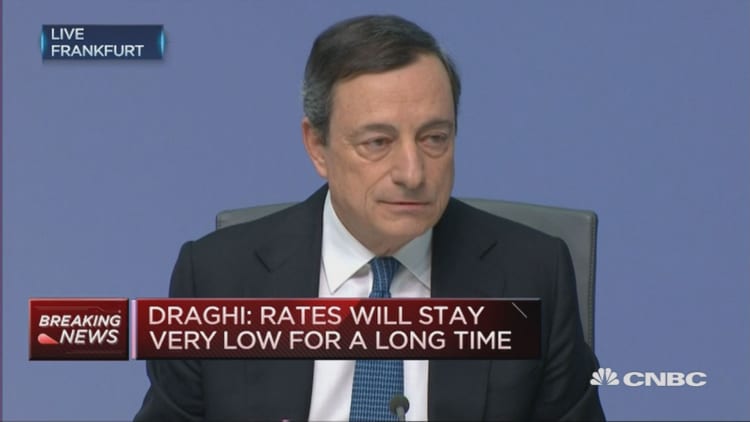
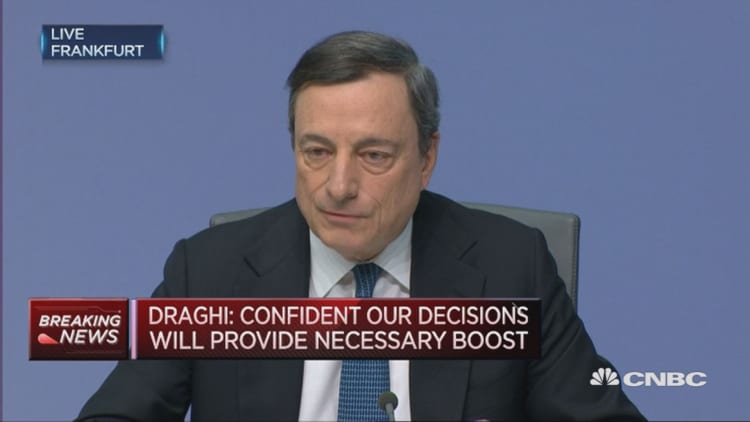
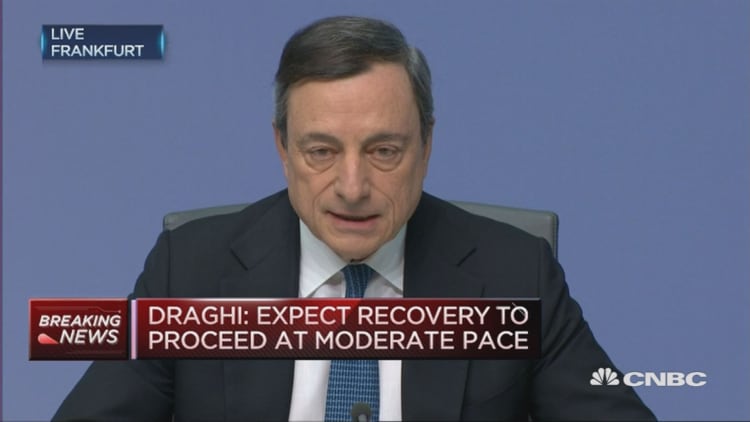

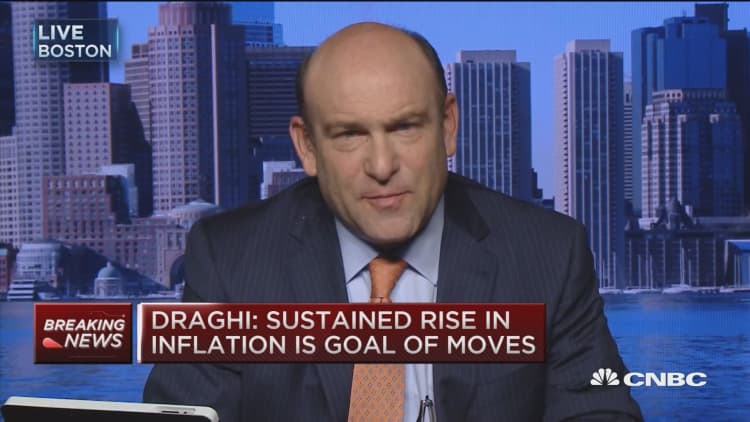
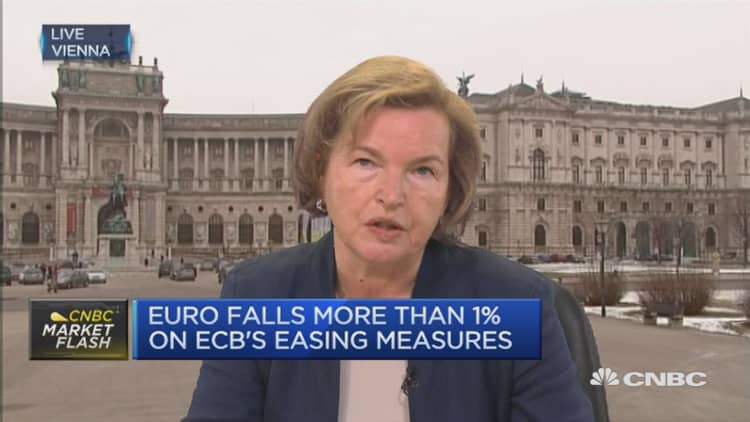
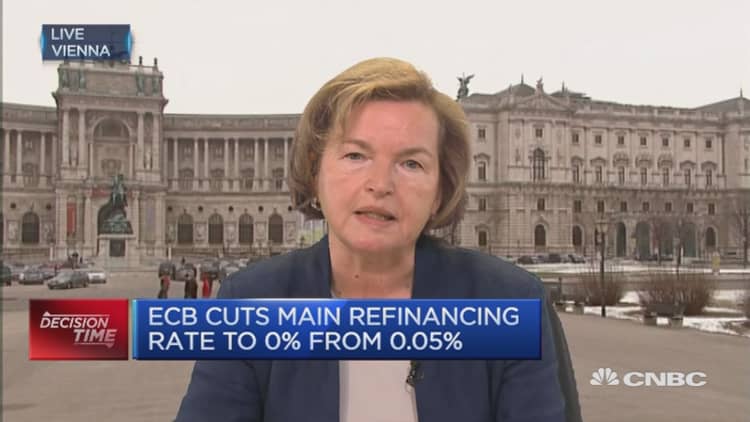
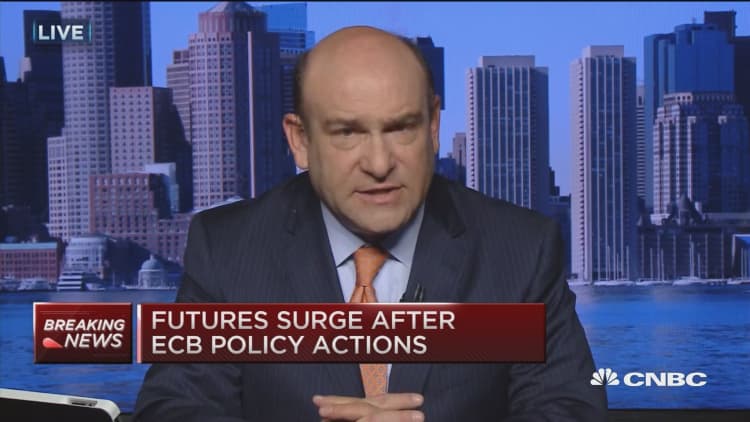

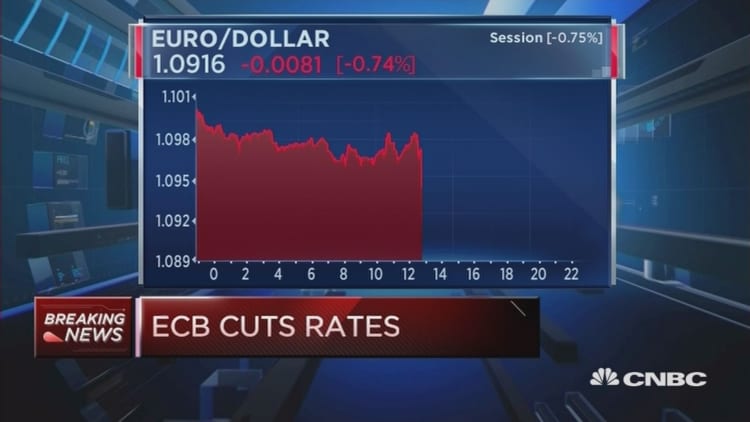

The European Central Bank (ECB) delivered a surprise package of measures to kickstart Europe's economy on Thursday, cutting its main interest rates and expanding its massive bond-buying program.
The bank's president, Mario Draghi, said the outlook for economic growth in the euro zone had been revised slightly down — mainly reflecting the weakened outlook for the world economy — but added that he did not anticipate needing to reduce rates further.
Draghi's comments sent the euro bouncing back off its session lows and yields on US Treasurys rising.
The euro zone's 19 countries are now seen posting average growth of 1.4 percent in 2016, rather than the 1.7 percent forecast in December.
HICP inflation in the euro zone is now seen averaging 0.1 percent in 2016.
New euro zone growth forecasts:
- 2016: 1.4 percent
- 2017: 1.7 percent
- 2018: 1.8 percent
In light of cuts to the growth and inflation outlook, the ECB announced on Thursday that it had cut its main refinancing rate to 0.0 percent and its deposit rate to minus-0.4 percent.
"While very low or even negative inflation rates are unavoidable over the next few months as a result of movement in oil prices, it is crucial to avoid second-round effects," Draghi said in his regular media conference after the ECB statement.
New inflation forecasts:
- 2016: 0.1 percent
- 2017: 1.3 percent
- 2018: 1.6 percent
The bank also extended its monthly asset purchases to 80 billion euros ($87 billion), to take effect in April. In addition, the ECB will add corporate bonds to the assets it can buy — specifically, investment grade euro-denominated bonds issued by non-bank corporations. These purchases will start towards end of the first half of 2016.
Plus, the bank will launch a new series of four targeted longer-term refinancing operations (TLTROs) with maturities of four years, starting in June.
At his regular media conference on Thursday, Draghi said that the set of measures would "reinforce the momentum of the euro zone's economic recovery."
The ECB went against tradition in presenting measures other than rate changes in its written statement.
Draghi said that interest rates would likely remain at present or lower levels for an "extended period of time and well past the horizon of our net asset purchases."
He denied however that the ECB was engaging in a "race to the bottom" in terms of global interest rates and said that extending asset purchases did not amount to currency intervention.
Draghi added that TLTROs had previously proved successful and provided an attractive long-term funding option for banks facing sizable refinancing needs in a volatile environment.
Negative rates: Good or bad?
Experts question whether the central bank's stimulative plans could harm the euro zone's fragile banking sector.
Negative rates — effectively charging banks to deposit money — have a significant impact on banks' profits as they cannot be passed on to consumers. Some analysts believe they amount to a tax on the banking system, compressing their margins, although Draghi said on Thursday that the experience of negative rates in the euro zone had been "very positive."
Indeed, the Euro Stoxx 600 banking benchmark has fallen sharply in the past 12 months, with the drop most pronounced last month amid concerns over the quality of some lenders' balance sheets.
"The fear is that by cutting rates further, even with these promises to try and insulate the banks from the effect, you reignite all of these concerns," Matt King, Global Head of Credit Strategy at Citi told CNBC, prior to the ECB announcement.
He added the risk with a further deposit rate cut was that it could be negative for the market and the banking sector in particular, while an increase in asset purchases would be much more positive. Any reference to the purchase of corporate bonds would be even more positive, he said, but unlikely.
Murray Roos, Global Head of Sales for Equities and Prime Finance at Citi told CNBC said further measures would likely strengthen the equity market, but warned that the returns could be diminishing.
"In order for equity markets to sustainably move higher, one would expect, or need there to be earnings growth, And earnings growth we haven't necessarily come see through to a great extent."
Geopolitical as well as macroeconomic factors that conspired to make for a very volatile start to the year in equity markets were stabilizing somewhat, Roos said. Decisive action today could further reduce the uncertainty and volatility, he added.





